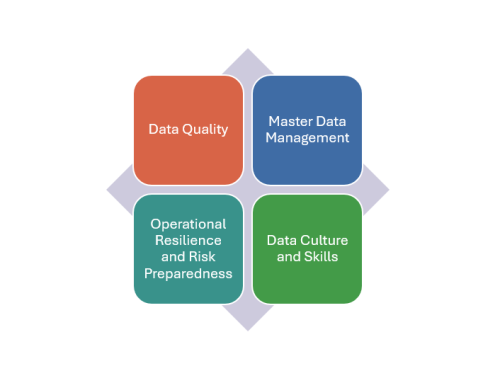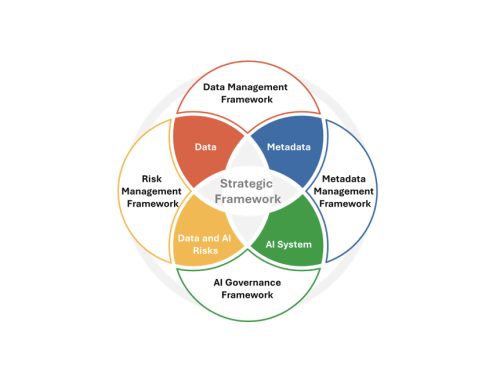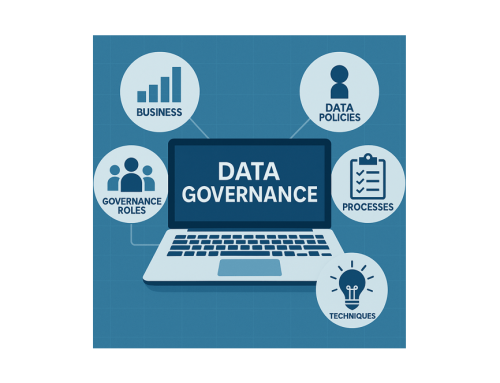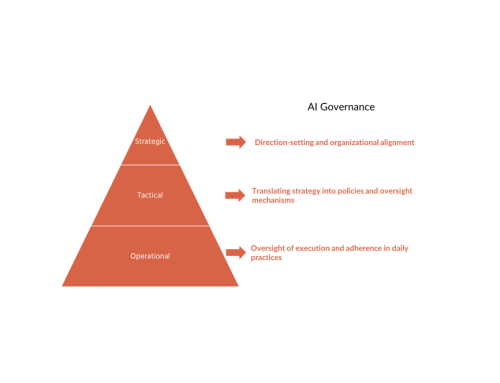This article explores trending topics in data architecture and modeling in 2025.
This is the fourth article in a series where I share my impressions and key insights gathered during the #DGIQ and #EDW2025 conference, as well as the top trending topics. This series offers a general summary and does not focus on any specific presentation from the conference.
In this article, I will focus on five key topics in Data Modeling and Architecture, discussed at the conference:
- Modern Data Architecture
- Data Modeling
- Semantic Layer
- Data Architecture Documentation
- Data Products
Let´s start with the first topic.
Modern Data Architecture
Modern data architecture must be business-driven, not technology-first.
Organizations are moving away from building architectures around tools or platforms. Instead, they prioritize business outcomes and align architectural components to support those outcomes. This includes identifying which analytics capabilities are required—such as reporting, self-service, machine learning, or real-time processing—and designing an architecture that enables them.
Architectures must support multiple data types, sources, and delivery modes.
A single enterprise may need to handle structured, semi-structured, and unstructured data coming from internal systems, external platforms, and real-time devices. Modern architectures accommodate both batch and streaming ingestion patterns, supporting a mix of historical data warehousing and near real-time analytics. This flexibility requires architectural layering, including raw data zones, curated datasets, trusted data products, and governed interfaces for delivery and consumption.
There is no one-size-fits-all architecture; organizations must select from a range of modern types.
Key architectural models include the Data Lakehouse, which combines the flexibility of data lakes with the reliability of data warehouses; the Data Fabric, which enables unified access and integration across distributed environments; and the Data Mesh, which decentralizes data ownership and emphasizes domain-oriented data products. Each model offers distinct strengths, depending on the organization’s structure, data maturity, and strategic objectives.
Cloud-native platforms offer elasticity, modularity, and speed—but require careful re-architecture.
Rather than simply migrating on-premises systems to the cloud, organizations are re-platforming or re-architecting to take full advantage of cloud capabilities. These include scalable compute and storage, serverless processing, microservices, and infrastructure-as-code. Cloud-native patterns support agile development and continuous integration but require upfront planning to avoid fragmentation and maintain data quality, governance, and observability.
Data engineering must accommodate multiple processing paradigms.
Five major approaches are typically used: traditional ETL pipelines; in-database ELT transformations; low-code data wrangling; streaming data integration; and virtualized access via SQL or APIs. A modern architecture must support a mix of these options to serve different personas—from data engineers and data scientists to business analysts and citizen developers.
A layered and governed data ecosystem is key to scale and reuse.
Effective architectures separate concerns across layers: ingestion, processing, storage, delivery, and governance. Data moves from raw layers to curated and trusted zones. Throughout the process, active metadata management, orchestration, security, and quality controls ensure traceability, trust, and compliance. This structure supports the reuse of data assets across multiple use cases and teams.
Modern architecture is not static—it must evolve continuously.
With the rapid growth of AI, real-time applications, and advanced analytics, data architecture must be designed to be adaptable. Incorporating components such as vector databases, knowledge graphs, and model pipelines ensures that the architecture can support emerging business needs.
Data Modeling
Data modeling remains essential in both traditional and AI-driven environments.
Despite the proliferation of new technologies, data modeling is still fundamental to understanding, organizing, and managing data effectively. It fosters a shared understanding between business and technical stakeholders, promotes consistent terminology usage, and supports the creation of accurate, reusable data assets.
Different modeling levels are required to support the full data lifecycle.
Effective data modeling spans multiple abstraction levels—from semantic and conceptual to logical and physical. Semantic models clarify meaning and context. Conceptual models define core entities and their relationships. Logical models structure data for business processes and analytics, while physical models ensure optimal performance in storage and access. Together, they enable smooth transitions from business needs to technical implementation, particularly important in scalable, governed environments.
AI and machine learning lifecycles depend on structured, validated data models.
Each phase of the AI lifecycle—from problem definition to model deployment—relies on different types of data models. Semantic and conceptual models provide business context, clarify objectives, and support explainability. Logical models help select relevant features and identify data bias, while physical models guide data integration and preprocessing for efficient training and execution. Well-designed data models enhance model quality, reduce risk, and support monitoring in production environments.
Data models reduce complexity and support responsible feature engineering.
In machine learning, choosing the right features is critical. Logical and physical models reveal relationships and redundancies that inform feature selection, reducing noise and improving algorithm performance. They also support consistency in data cleansing, transformation, and integration processes. By documenting integrity rules, attribute constraints, and encoding standards, models help identify and address issues early, before they impact AI outcomes.
Modern data modeling must adapt to diverse architectures and tools.
Today’s environments often mix relational, NoSQL, graph, and document-based systems. Modern modeling practices must retain core principles while adapting to new paradigms. For example, logical normalization can guide effective schema design even when the physical layer is implemented in document or graph databases. Hybrid modeling approaches enable organizations to maintain coherence while leveraging the distinct strengths of various technologies.
Data modeling strengthens data governance and supports agile delivery.
Models serve as a bridge between data governance and agile development. They help define and enforce standards, ensure reusability, and reduce redundant efforts. Even in iterative and fast-paced settings, models support traceability and quality. Business term models (BTMs), logical data models, and physical schemas all contribute to robust and governed data ecosystems, providing continuity across initiatives.
Semantic Layer
A semantic layer is crucial for transforming data into actionable business insights
It organizes and abstracts data from multiple sources—structured, unstructured, and semi-structured—into a unified, business-aligned view. This layer bridges the gap between complex data environments and the users or systems that consume the data. It enhances accessibility, context, and meaning, enabling both human understanding and machine-readability.
Semantic layers shift data management toward knowledge-centric architectures.
Modern demands—especially AI and advanced analytics—require more than traditional data management. Semantic layers connect data to context through components such as metadata, taxonomies, ontologies, and knowledge graphs. This shift supports reasoning, inference, and richer queries, laying the groundwork for automation, intelligent applications, and generative AI.
The effectiveness of a semantic layer depends on a well-structured architecture.
A robust semantic architecture must integrate metadata from diverse sources, enrich it through taxonomies and ontologies, and deliver it to end users through APIs, dashboards, search tools, or AI systems. High-performing implementations combine graph databases, cataloging systems, and orchestration tools to ensure semantic consistency and accessibility across the enterprise.
Not all data use cases require a semantic layer—its application must be targeted.
A semantic layer is most valuable when organizations must unify fragmented data, integrate structured and unstructured content, or provide contextualized knowledge for analytics, search, and AI. It is less suitable for flat, transactional data or environments with rigid schemas where meaning is already embedded.
Next-generation semantic layers are evolving toward intelligent automation.
Emerging approaches incorporate AI agents to assist in ontology development, automate profiling, and enhance reasoning. These layers serve as the foundation for AI to not only consume knowledge but also manage and improve data systems. In doing so, they offer a path forward for bridging legacy environments with modern, AI-enabled operations.
Data Architecture Documentation
Clear, consistent documentation is critical for project success.
Many data projects struggle due to missing or poorly organized documentation. A well-structured documentation approach reduces misunderstandings, aligns stakeholders, and accelerates delivery. It enables teams to onboard faster, make informed decisions, and support long-term maintenance.
Data architects play a central role in connecting teams through documentation.
By acting as a hub between business, project management, development, and operations, data architects ensure that deliverables—such as data flows, system integrations, and data models—are visible, accessible, and useful to all roles. Their leadership in documentation helps unify project understanding and execution.
Visual documentation improves clarity and engagement.
Artifacts like conceptual, logical, and physical data models, system integration diagrams, and data conversion flows provide context far more effectively than text alone. Using templates, color coding, and naming standards increases consistency and readability across teams.
Documentation should be purposeful, maintained, and audience-specific.
Each diagram or document must serve a defined goal—whether for business stakeholders, analysts, or developers. Organizing documentation around business processes and future-state goals ensures it remains relevant and actionable throughout the project lifecycle. Proactive documentation isn’t overhead—it’s strategic value.
Data Products
Data products are governed, reusable, and user-focused data assets that deliver measurable value.
Unlike traditional datasets or one-off reports, data products are built with purpose, ownership, and quality in mind. They are designed for consumption, whether by people, systems, or AI, and must meet defined expectations for usability, reliability, and governance.
A successful data product has clear accountability, boundaries, and quality expectations
Organizations must define ownership, data scope, and SLAs through data contracts. These contracts specify who is responsible for the product, how it will be used, and what standards it must meet, including those related to privacy, timeliness, completeness, and correctness. Formal accountability ensures that users know who to contact, while automated validation and monitoring maintain trust and integrity over time.
There are different types of data products, each serving distinct needs
Foundational data products are built from core domain data and serve as authoritative sources. Composed products combine multiple sources to support specific business questions. Packaged data products deliver analytics-ready outputs and are often aligned to business teams or external consumers. Each type has different complexity, reuse potential, and governance requirements.
Architectural choices affect how data products are delivered.
Physical implementations prioritize performance through pre-processing and ETL pipelines. Virtual approaches enable agility by abstracting transformation logic at query time. Consolidated architectures optimize central access, while federated models allow distributed domains to maintain and serve data. Each option involves trade-offs in latency, scalability, and cost.
Data product management is a formal and strategic role, even if not always recognized as such.
Data product managers (formal or informal) define product scope, ensure quality and governance, manage the roadmap, and drive adoption. They balance stakeholder needs, coordinate teams, and oversee documentation. This role differs from data stewardship in that it focuses on value creation and consumption, rather than just compliance.
Intelligent data products are critical to AI readiness and enterprise agility.
They integrate metadata, support semantic enrichment, and align with AI pipelines. Through contracts, lineage, and standardized interfaces, they enable automated quality checks, usage tracking, and traceability. Their value multiplies when embedded in enterprise data marketplaces and aligned with hybrid architectures, such as data mesh and data fabric.
The “product” in data product means delivering with discipline, reliability, and purpose.
Ultimately, organizations succeed with data products when they embed product thinking—clear ownership, repeatable delivery, and measurable value—into their culture and operations.
Recommendations
- Align architecture to business outcomes, not technologies.
Build data architectures that prioritize agility, scalability, and relevance to real use cases. Choose architecture types—such as lakehouse, mesh, and fabric—based on strategic goals and maturity, rather than trends. - Treat data modeling as a strategic, ongoing activity.
Implement and maintain semantic, conceptual, logical, and physical models to support interoperability, analytics, and AI. Ensure models guide not only design but also governance and reuse. - Invest in a semantic layer to enable data understanding and AI readiness.
Use ontologies, taxonomies, and knowledge graphs to contextualize metadata and support search, automation, and reasoning across systems and teams. - Establish standards and ownership for metadata and knowledge management.
Treat metadata as enterprise infrastructure. Integrate it into catalogs, contracts, and APIs. Define clear roles, processes, and tooling for managing conceptual and construction-level models. - Adopt a product mindset for data delivery and reuse.
Governed, discoverable, and valuable data products should be built with clear accountability, contracts, and lifecycle processes. Embed data product roles and practices into enterprise architecture and governance models.





